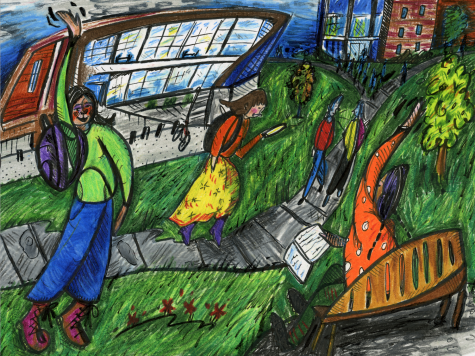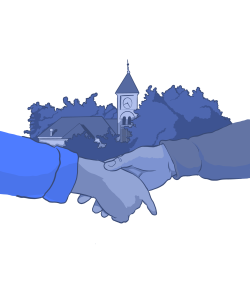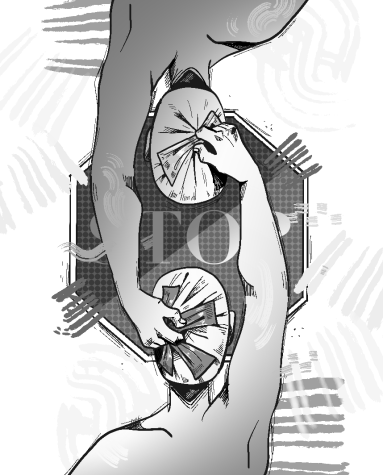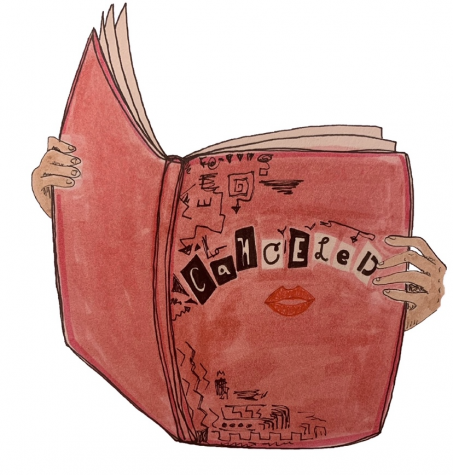Strangers, Acquaintances, Friends
October 7, 2021

College campuses are a breeding ground for the question and worry: how do I make friends? First-years are traditionally burdened by the task of friendship-forming, but recent circumstances have led second-years, new to campus, and dazed upperclassmen, to stumble under its weight. Whitman’s a small school, so no face will startle you at this point, but still, how many people have you yet to talk to, and how many have you yet to avoid?
Midway through my interview with Buddy Moench, junior and CS major, he perplexedly asks me if I even had a question. We were vaguely circling around ideas pertaining to the nature of friendship. I was asking opaque questions and he was providing detailed answers, but my questions were non-sequiturs, and his answers hung in the air.
He asked me if anything had sparked my interest to write this piece. ‘This,’ referring to what I had labeled my piece at the time: ‘navigating the spaces between stranger, acquaintance and friend.’ So I told him that I was increasingly feeling a divide between two sets of people in my life: those whom I am familiar with and can talk to as myself, unfiltered and unabashedly; and those whom I am unfamiliar with to the extent that I cannot speak as myself, not openly nor without hesitation. And this divide seemed so thick that I was wondering how people had managed to cross to ‘my’ side in the first place.
Moench differentiated for me between strangers, acquaintances and friends. Strangers are whom he has never met; acquaintances are whom he has met, remembered and recognized on a later occasion; friends are whom he has shared with more than one vulnerable conversation. (On why one vulnerable conversation isn’t enough to be Moench’s friend: “well, sometimes I just pour my soul out.”) He approximated who in his general vicinity would qualify as a stranger, acquaintance and friend, respectively: 90% strangers, 9% acquaintances and 1% friends.
Strangers mostly become acquaintances for Moench at parties and on social media, whereas only a few acquaintances come from class. In fact, he doesn’t really know his classmates; in his 30-student history class, he knows one name. He agreed with me that a larger-sized class paradoxically tends to mean knowing fewer classmates. At parties and on social media, he gets acquainted with friends of friends. Instagram will algorithmically prioritize on his feed ‘closer’ people in his social circle. Social media, he estimated, provides him with 30% of his friendships.
Disliking my ‘strangers, acquaintances and friends’ categories, he drew a molecular-esque structure on the whiteboard behind me to represent a ‘social network’ web. He called the circles and their connecting lines ‘nodes’ and ‘edges’; he talked about degrees of separation, probabilities and stochastic methods. I nodded as he explained, but I now wonder if our social networks are probabilistic at all. Don’t we actively choose whom to talk to and shy away from?
Moench, a big Hegel fan, characterized our relations to one another in terms of subjects and objects. (In fact, he claimed that everything’s a matter of subject and object. I don’t know what this means. He did tell me multiple times to read Hegel, though.) As ourselves—a subject—when we speak to someone else—an object—we are instrumentalizing something. When we use an excuse to talk to someone: “you want to talk to them and you’re making something up, instrumentalizing something else to talk to them,” he said. And when we use a reason to talk to someone: “you’re instrumentalizing them for your reason.” I told him that excuses sound nicer, so he added: “if somebody comes up with an excuse to talk to you, that’s great—for you!”
Moench loves people and loves talking to people; they’re exciting to him and they’re his favorite thing. But he said that you can’t have too many friends because life—and by life, he means work—gets in the way.
“Work gets in the way of your goals of friendship. Alienated labor gets in the way of your goals of friendship. Misallocation of labor gets in the way of your goals of friendship.”
He told me that friendship is about vulnerability, so I asked him what vulnerability is. “When I tell people about my emotional experience of the world and my true … convictions. Convictions that are emotionally important,” he said.
He elaborated on what’s worth sharing: “lowest points, truly embarrassing moments. Not just like ‘you farted in class’ or something, but like things that would probably prevent you from getting a job or entering Royal society.” He added: “things that transgress; things that you have to hide.” And: “vulnerability means that someone can attack you and hurt you”; as well as: “it’s an opportunity to build trust.”
He told me that romance is a little different: “I think I would have to have some more propinquity—like personal similarity to someone. We’d have to have a similar disposition, way of being, attitude, perspective.”
I asked, “how many people in your life can you tell anything? Is there anyone?” He said yes. I added, “how many people are there—can you quantify it?” He said there’s one person, but he can’t tell her everything. “So there’s no one that you can tell everything?” Yes, he said.
So I asked him if he would want there to be a person to whom he could tell everything. But he found this ridiculous. “To have that person would defeat its own purpose. If you could tell someone everything, that would be you! By definition. But the difference between people is what means that you can’t say everything to them!”
He gave me an example of what shouldn’t be shared: “murderous impulses.”
He knows someone’s his friend when they can come over to his place whenever they want. And it’s important to know when someone’s your friend because it’s important to understand the boundaries of relationships. “If I asked someone if I could come to their house right now because I needed to talk to them about something in my life … would it be socially appropriate—would they think it was weird that I was doing that? Would they feel some kind of pressure to say ‘yes, you can’ because they don’t want to risk harming some budding friendship that we have?”
I found the notion of budding friendships compelling so I asked him to say more. “It’s about whether you want to be friends. And how much you have in common and how well you can leverage how much you have in common in order to increase your closeness.” Easier said than done.
The first time I talked to Linden Corson (junior, anthro major, pronouns: all!) was when we ate wontons at a mutual friend’s place. The second time was when I knocked on her door—we live in the same dorm—and asked her to be interviewed. She made some uncomfortable grunts but eventually obliged. We chatted outside, sitting on a side of Cordiner.
Corson told me he makes friends from class and from clubs such as D&D and PRISM. Most of the people he interacts with are acquaintances and not friends because it takes a lot of time (years) for him to consider someone a friend. He said that he couldn’t have more than ten close friends.
But friends are rather fluid for Corson. She said that orientation was important for making friends and claimed that she spent freshman year with six different friend groups. One of which survived to be her current posse. She values friends that can make sexual jokes and be open since vulnerability is what makes her closer to others. She can share most of herself with others and values reciprocity. Things that she can admit to herself are things that she can share. She acknowledged that friends can like each other to differing degrees but as long as she and her friends are placing the effort to value one another, then it’s alright. And quality time builds proximity. She doesn’t have to spend a lot of time or actively stay in touch with someone to feel close to them.
He admitted that a part of friendship is its transactional nature, but maintained that a friend’s instrumental value should only be an afterthought. He said that he’s not great at making friends himself, but is good at befriending others that are good at making friends.
I’m still curious about how relationships transition, so I later follow up with Corson, asking her if she can tell whether a friendship’s going well or not. She said she doesn’t really know—but reemphasizes effort. “I can put in all the effort I think is reasonable, but if they aren’t putting in any effort, it just doesn’t work.”
He also returned to the idea of quality time. “I can tell a friendship is progressing by the amount of quality time we spend together.” For him, that can manifest as “fun arguments, discussing emotions and being open.”
Friendship is essentially about vulnerability. And vulnerability is about sharing yourself openly. So how do you be vulnerable? How do you cross the divide of the stranger to the friend? One way to go about this would be to collapse these categories altogether.
I was talking to a peer about my article, and he emphasized that friendship is a process of unfolding, of the self in community. Everyone you see, know and meet aren’t strangers or mere acquaintances, but on-the-way-to-friends. So every time you talk to and interact with someone, there’s a potential in that moment—for you to step outside of yourself and sense something together. Commonly sensing the world and sharing that sense. I guess life is a series of begrudgingly reminding yourself that the risks, in sharing vulnerabilities, are always outweighed by the rewards. Again, easier said than done.








